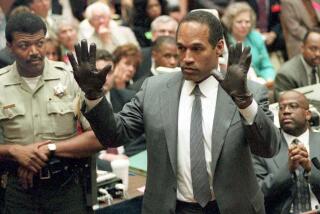Some Murdered Kids Get More Attention
More than anything, some journalism and missing-child experts say, it was the brutal and haunting details of Samantha Runnion’s abduction and killing that made her case an overnight media sensation.
There was the brazen nature of the kidnapping, in broad daylight on a quiet Orange County street. Then the discovery of the 5-year-old girl’s body by a hiker in the Cleveland National Forest, his anguish captured on a 911 tape and played over and over on television. The sheriff issued an unusual warning that a child killer was on the loose and could strike again soon. And finally, Samantha’s killer, police said, had sexually assaulted and asphyxiated the girl, then tauntingly left her displayed in the open as a “calling card.” Even her kicking and screaming hadn’t been enough to deter her assailant. Parents across the country wondered helplessly: What more can we do to protect our children?
“I hate this expression on television,” said Jerry Nachman, an MSNBC host, but “you have every parent’s worst nightmare. This is not a kid who didn’t understand the rules, [but] one who is sitting on the wall outside her house with a playmate and gets snatched by a guy, dragged away from her home kicking and screaming, is sexually abused and suffocated to death. How much of a reach is it to call that a story?”
But the prominent coverage given Samantha’s case contrasts sharply with all but a handful of other recent incidents of missing and murdered children across the country. On Friday, as detectives announced the arrest of 27-year-old Alejandro Avila in connection with the case, some media professionals and other observers said that factors such as ethnicity and economic class also may explain why Samantha’s story led national newscasts and captured front-page headlines across the country, while many other recent cases of missing and/or murdered children have not.
“We tend to, in the media, on the national level, place more weight with children who are white, children who come from economic circumstances that are middle or upper level, and we tend to dismiss
(Samantha Runnion fits the profile only partially. The child of a single mother, Erin Runnion, she was from a working-class neighborhood in Stanton.)
Since the start of this year, at least five abducted children have garnered varying degrees of national media attention. Besides Samantha, they include Danielle van Dam, snatched from her bedroom in her parents’ San Diego home in February (David Westerfield, a neighbor, is on trial for her murder); Alexis Patterson, 7, who disappeared in May after leaving for school in central-city Milwaukee; Elizabeth Smart, 14, who is feared to have been kidnapped at gunpoint from her family’s Salt Lake City home June 5; and Jahi Turner, 2, who disappeared in San Diego in April.
Of the five, Danielle, Elizabeth and Samantha were front-page news across the country, and their cases have been given prominent play in national TV newscasts. It’s a mark of the impact of media saturation that even many media executives rattle off the names of Danielle, Samantha and Elizabeth, all of whom were white, and then tack on, “and the girl from Milwaukee”--meaning Patterson, who is African American, as is Turner. Neither case got immediate widespread national attention, which led some to conclude that race and class were at work when news executives were making their coverage decisions.
Nachman disputes that, saying a number of factors in the Patterson case, including confusion about custody, made it a murkier story. “It’s different circumstances,” he said. But other executives say race and class issues are involved in deciding which cases the media will latch onto out of the several hundred nonfamily-member child kidnappings per year.
“It pains me, as a black man, a black journalist and as a journalist,” said Will Sutton, deputy managing editor of the News & Observer in Raleigh, N.C., and former president of the National Assn. of Black Journalists. “Because for me it’s a matter of accuracy, balance and fairness as well as completeness.”
Sutton said that the News & Observer ran its coverage of the Runnion story inside its A section, as it has done with stories about other recent child victims. “We tend not to put crime stories on the front page and play them up,” he said.
Besides journalists, some missing-child experts expressed concern about disproportionate national reporting on stories like Samantha’s. “We wish that all the cases had equal coverage,” said Nancy McBride, executive director of the National Center for Missing & Exploited Children/Florida in South Palm Beach.
At the same time, she said that Samantha’s case was unusually potent psychologically, in part because of the audacity of her attacker. “I think we need more resources devoted to prevention, because even though the numbers are staying somewhat stable, the attempts are more brazen,” she said. “And that’s very frightening.”
According to a number of sources, there are between 200 and 300 child murder-abductions annually by other than family members in the United States, a number that has remained fairly steady for at least the last decade. More than a million children go missing each year, but the majority, perhaps as many as 90%, are estimated to be teenage runaways.
“I’ve been around for 20 years and I can’t remember the time when we’ve had so many at once,” Nancy McBride said. “But I’ve also learned that, for whatever reason, these cases sometimes come in clusters.”
David Finkelhor, director of the Crimes Against Children Research Center at the University of New Hampshire, said that while the dramatic content of Samantha’s story accounts for the attention it has received, sociological factors may also have played a role. “The young age of the child is particularly dramatic,” he said. But he believes that “kids from minority, low-income, inner-city environments, they just don’t get the same amount of publicity.”
Others attribute the attention paid to the Runnion, Smart and Van Dam cases to factors such as the willingness and ability of the girls’ parents to connect with the country through the mass media. The Smart case had lots of compelling video and pictures of a child from “what’s considered a typical American family, middle-class or upper middle-class,” said Jim Murphy, executive producer of the “CBS Evening News.”
Murphy had criticized his NBC News rivals recently for what he considered excessive dwelling on the Smart kidnapping. But Wednesday night, he led his broadcast with the Runnion case, while “NBC Nightly News” chose to discuss a suicide bombing in Israel, Iraq, the economy and the Securities & Exchange Commission before getting to the kidnapping. ABC’s “World News Tonight” also led with the bombing, then other news, before talking about the kidnapping 13 minutes into the show.
“It was a hard decision for me to make,” Murphy said, but he was persuaded by arguments that “this case really affected people even more than most because it came so soon after the Smart case and because it was so unbearably grim. I didn’t expect to lead with it that day, but in the end, it felt like the right thing to do.”
Paul Slavin, executive producer of ABC’s “World News Tonight,” said the media have latched onto the story because “everybody who is a parent, everybody who is thinking of becoming a parent, everybody who knows a parent is terrified when this happens.”
Slavin said he didn’t lead his broadcast with the story, however, because “it was an interesting story, but it was not the most important story of the day from our point of view.”
In San Diego, several TV stations have preempted regular daily talk shows and soap operas for live coverage of the Van Dam trial since it began in early June. One station, KUSI, which is not affiliated with any network and thus has more freedom to change its schedule, has carried the trial virtually gavel-to-gavel, with an additional one-hour special recapping events each night.
The station, which promotes itself as having more local news than competitors, decided on the blanket coverage, which could extend for three months, “knowing that the Van Dam case was really important to San Diego,” said Joe Riddle, night executive producer. He compared it to the O.J. Simpson trial, when viewers “said it was way too much but then made it the highest-rated” programming.
In its Thursday coverage of the Runnion case, CBS followed up with a story that put child kidnappings in perspective, Murphy said, adding that there is an “unjustified frenzy that happens with most of these cases.” Indeed, the recent clustering of kidnappings, just like last summer’s shark bites, may help create the appearance of a trend where one may or may not exist. “I’m frequently going to say [that] we in the business make generalizations out of aberrations,” said MSNBC’s Nachman.
Nachman, whose show focused extensively on the topic Thursday, said the story might be unique in his three decades of crime reporting. “When was the last time you saw a police official go on television and flat-out announce that they’re looking for a serial rapist/serial killer and predict the guy’s going to strike again in 24 hours?” he said.
More to Read
Sign up for Essential California
The most important California stories and recommendations in your inbox every morning.
You may occasionally receive promotional content from the Los Angeles Times.











